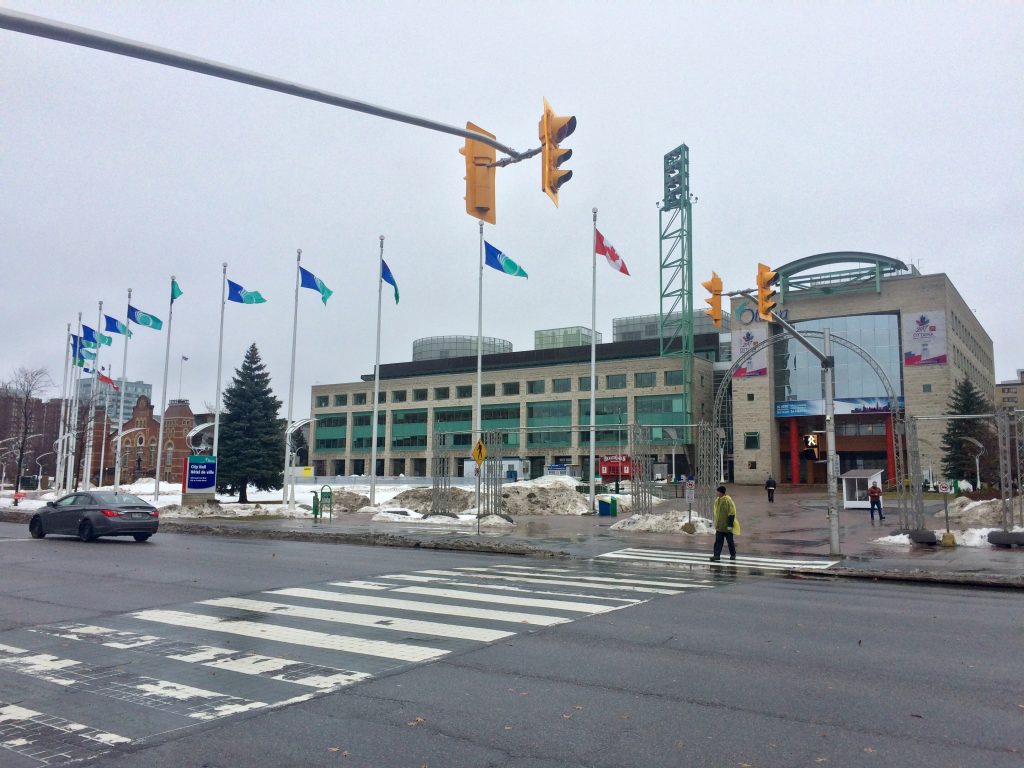City Hall to add new layer of security with bollards
By Isaac Würmann
Ottawa City Hall will be the latest building in the capital region to ramp up security by installing bollards.
Earlier this month, Mayor Jim Watson said the barriers would be installed to prevent car-ramming attacks similar to those that have occurred recently in cities such as Berlin, Barcelona and New York City.
“We have seen, unfortunately and sadly, the world change,” Watson said in an interview on CBC’s Ottawa Morning on Jan. 11. “You look at the Christmas market in Berlin and the weapon of choice, sadly, is something as crude as a truck ramming into people.”
Bollards — short posts that prevent vehicles from driving into an area while still allowing pedestrian movement — are part of a plan “to ensure the safety and security” of the public, said Pierre Poirier, the city’s manager of security and emergency management.
Other locations in the city with security bollards include the United States embassy and Parliament Hill.
The decision to install the barriers outside City Hall follows a 2017 security report that recommended protecting Marion Dewar Plaza, the festival space between the building and Laurier Avenue, Poirier said.
It’s not so much City Hall itself as the crowds that gather in the plaza that make the site a potential target, said Stephanie Carvin, an assistant professor of international affairs at Carleton University.
She recalls visiting the plaza last summer to witness the robotic spectacle La Machine during the Canada 150 celebrations.
“It was one of the largest crowds I’d seen in Ottawa, other than Canada Day, and there was no security other than police officers on bikes,” Carvin said. “Which was pretty nice, but it also potentially could have been a target.
Other major events held in the plaza over the past year include Poutine Fest, Ottawa Race Weekend and ceremonies such as the Canada 150 cauldron lighting.
Thirty to 40 bollards will be installed around the plaza, although the cost of these barriers has not been determined, Poirier recently told the Ottawa Citizen.
A single, impact-resistant security bollard can cost between $30,000 and $60,000, according to Brad Done, vice-president of Reliance Foundry, a British Columbia-based bollard manufacturer whose clients include the U.S. Federal Reserve and the City of Montreal.
“We’ve just seen a non-stop increase in interest in the products,” he said.
With the increase in interest, Done said bollards have evolved to withstand the impact of high-speed vehicles and to include technology such as surveillance cameras and motion sensors.
However, not everyone is celebrating the increasing use of these security barriers.
Local landscape architect Mary Faught was an outspoken opponent of bollards at the U.S. embassy, which she said initially blocked traffic on Sussex Drive and made the embassy look “like a fortress.”
Faught said she has similar concerns about bollards at City Hall. Aside from being an eyesore, she said the barriers could restrict access to public space in the plaza.
Instead, she said alternatives such as boulders or “nice looking blocks of limestone” could be used to prevent vehicles from accessing Marion Dewar Plaza without segregating the space from the rest of Centretown.
“There have been some really nice plazas built with bollards, because we have been starting to take into consideration designing these plazas for safety issues as well,” said Faught.
There is also debate about whether security barriers are the best strategy to keep the public safe.
While bollards may make it harder to target specific locations such as Parliament Hill or City Hall, Carvin said they don’t stop violent extremists from attacking a different location.
“The thing we have to understand about lone actors is that they are opportunistic,” she said. “They’re looking for an opportunity to attack.”
At the end of the day, the best way to protect the public remains “old-fashioned policing,” she said. That means having community contacts and a good relationship with intelligence agencies so police can stop an attack before it happens.
“You’re not going to be able to harden every target,” Carvin said. “We don’t want to live in a giant bubble.”

